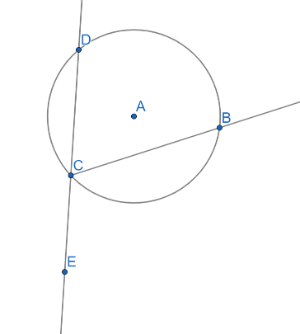Math 2 | Phase 2 Week 4 Days 1/2 | Central & Inscribed Angles
Lesson Overview & Quick Angle Review
Question #1 - About Questions in GeoGebra
(NOTE: The questions in this lesson do not confirm whether you are right or wrong. When you show the answer, you are only confirming whether you are right for your own knowledge. In other words, you're not penalized for wrong answers.) QUESTION: When you click to show the correct answer, does GeoGebra confirm whether you're right or wrong? (Yes, this is a "multiple" choice question with only one "choice".)
Question #2 - Obtuse Angles
What makes an angle obtuse?
Question #3 - Acute Angles
What makes an angle acute?
Question #4 - Right Angles
What makes an angle right?
Question #5 - Naming Angles
In the sketch, I labeled the angle "". There is one other choice of labels that I could have used. Write that choice in the space below, and then check to see if you're right. (In the notes, I ask you a question to see if this review is all making sense.)
NEW Concept #1 - Defining Central Angles
Question #6 - Define Central Angle
What makes an angle a central angle?
Questions #7 - Measuring the Central Angle
Once you have a central angle, grab point S and move it around. What do you notice about how this angle is measured that is different from what you may be used to?
Question #8 - Measuring a Central Angle's Intercepted Arc
You should notice that as soon as you made a central angle, part of the circle turned blue and thicker than the rest of the circle. This portion of the circle is called an "arc", and you should fill in your notes before answering question 8. Definition - Central angles intercept a portion of a circle, which we call an "arc". (A "minor arc" is less than half of a circle. A "major arc" is more than half of a circle. A "semicircle" is exactly half of a circle.) What simple relationship do you notice about the measure of the arc and the measure of the central angle?
NEW Concept #2 - Defining and Finding Measures of Inscribed Angles
Question #9 - Define Inscribed Angle
What makes an angle an inscribed angle?
Be careful with this definition!
One inscribed angle, and one non-inscribed angle.

Question #10 - Measuring Inscribed Angles
As soon as you made inscribed in the sketch above, you should notice that an arc appears from point E to point S, as well as a central angle that intercepts the same arc. Now move points S or E around, but keep H between them. Observe how big the measure of is (shorthand: ) compared to the central angle, that intercepts the same arc. This isn't quite as obvious as the relationship you saw in Question #8, but I still think you'll see how big the inscribed angle is. (Take a guess, and then check to see if you're right by checking your answer below.) How big is the inscribed angle's measure compared to the central angle's measure?